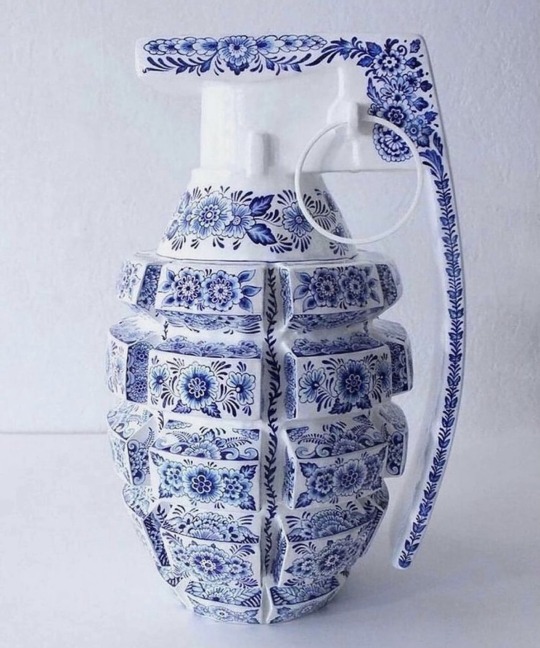#grenade
Explore tagged Tumblr posts
Text

Escape from the Bronx (Enzo G. Castellari, 1983)
80 notes
·
View notes
Text

4K notes
·
View notes
Text

So I was like: Marbles..... but what if they were hand grenades?
#sfm#sfm poster#source filmmaker#sam and max#sam and max freelance police#freelance police#grenade#marbles
593 notes
·
View notes
Text

sculpture by Helena Hauss
3K notes
·
View notes
Text


hc jay does NOT play about his karaoke songs
#ninjago#lego ninjago#my lowest effort post yet#aphid’s ninjashits#ninjago jay#jay walker#nya ninjago#kai ninjago#ninjago kai#jaya#ninjago jaya#i guess#zane also joins him zane and jay often sing musical numbers together for fun#other songs on his list include#chasing pavements#hello#the man who never moves#grenade#when i was your man#and hula hoop by loona#someone think of other sad breakup core songs#he’s singing just give me a reason and the one that got away in the drawngs btw#if you somehow couldnt find that out
727 notes
·
View notes
Text

Generation After Generation
The Courageous Popular Uprising. Generation after Generation , until Total Liberation.
Artist: Marc Rudin/Jihad Mansour (1945-2023)
Circa 1989
97 notes
·
View notes
Text

Photo originale par Steph-Photo
Une image que j'aime beaucoup et qui trône encore dans mon bureau ... L'escalier du Palais de Charles-Quint à l'Alhambra de Grenade (Espagne)
#original photographers#steph photo#original post#french photographer#photographers on tumblr#insolite#espagne#spain#grenade#alhambra#escalier#stairs#noir et blanc#black and white photography#palais#histoire#architecture
164 notes
·
View notes
Text
I lived in a KFC but they started selling grenades and unicorn meat.
464 notes
·
View notes
Text

Angel of Destruction (Charles Philip Moore, 1994)
112 notes
·
View notes
Text
Oh, what could this grenade possibly be used for?
(I'm still alive, I swear)
69 notes
·
View notes
Text

𝐋𝐨𝐯𝐞 𝐥𝐢𝐤𝐞 𝐚 𝐠𝐫𝐞𝐧𝐚𝐝𝐞— 𝐊. 𝐁𝐚𝐤𝐮𝐠𝐨
Katsuki Bakugo × reader
Master List
Sypnosis: Katsuki Bakugo would do anything for you, but when he finally asks if you'd do the same, you're not sure you have an answer.
☆open request☆
Comment to be tagged in text post, or request!!

You never asked him to love you.
Katsuki Bakugo just did. Fiercely. Without hesitation. Like breathing.
And for the longest time, you let him.
You met in high school, a messy kind of connection that wasn't really friendship, wasn't really romance either— just something magnetic and inevitable.
It was impossible not to be drawn into Bakugo’s orbit, not to feel the weight of his presence even when he wasn’t saying a word. You liked the way he carried himself, like he had something to prove to the world and he would— no matter what.
But high school ended, and life moved forward.
▶︎˖𓍢 ✧˚.🎀
College was a whirlwind of discovery for you. New experiences, new people, new temptations. You found yourself drawn to the unknown, to the thrill of exploring people who weren’t Bakugo.
So, you made a deal.
You and Bakugo never put a label on it. No relationship, no expectations, just the promise that when you needed each other, you'd be there. A situationship. A mess of tangled sheets and whispered words in the dead of night.
And Katsuki— stupid, loyal Katsuki— agreed.
Even though he never touched anyone else.
Even though it broke him a little each time you talked about someone new.
▶︎˖𓍢 ✧˚.🎀
“You know I don’t love them,” you told him one night, drunk on cheap beer and bad decisions.
Bakugo was lying beside you on the dorm bed, the room smelling like your perfume and his shampoo. His fingers trailed over the curve of your waist, memorizing your body like he hadn't already done it a hundred times before. His jaw clenched, but he nodded.
“Yeah,” he muttered. “I know.”
But knowing didn’t make it hurt less.
▶︎˖𓍢 ✧˚.🎀
It wasn’t like you meant to hurt him.
You weren’t cruel. You weren’t malicious.
You were just young.
And maybe a little selfish.
Because you knew— God, you knew— that Katsuki Bakugo would never leave you. You knew you could come back to him, bruised from someone else’s touch, and he’d still hold you like you were the only person in the world.
And every time you did, every time you whispered his name in the dark, he let himself believe— just for a moment— that maybe you’d stay.
But you never did.
Because there was always someone new. A boy with a pretty smile. A girl with soft hands. People who made you feel alive in ways that weren’t so damn permanent.
Because Katsuki Bakugo was permanent.
And that scared the hell out of you.
▶︎˖𓍢 ✧˚.🎀
The worst part?
He never made you feel guilty.
Never asked you to stop.
Never told you it hurt.
He just stayed.
Waited.
Loved you quietly, even when you were too blind to see it.
▶︎˖𓍢 ✧˚.🎀
The first time you realized how much you were breaking him was on a night like any other.
You had gone out with some friends, let a stranger buy you drinks, let them put their hands on your hips as you danced. It wasn’t serious. It never was. Just a few moments of fleeting fun before you inevitably ended up in Bakugo’s arms, like always.
But that night, when you stumbled into his apartment, smelling like someone else’s cologne, Bakugo didn’t pull you into his arms.
He just stood there, staring at you, his expression unreadable.
“What?” you laughed, kicking off your shoes. “Why are you looking at me like that?”
Bakugo ran a hand through his hair, exhaling sharply. “Do you even know what you do to me?”
Your smile faltered. “Katsuki—”
“I’d do anything for you,” he cut you off, voice rough. “You know that, don’t you?”
Your throat tightened. You didn’t like the way he was looking at you. Like you were something fragile. Like you were something he was afraid to lose.
“Katsuki,” you said again, softer this time.
He took a step closer. “You could ask me to walk through hell for you, and I’d do it. No questions. No hesitation.”
Your heart pounded.
You didn’t know what to say to that.
So you said nothing.
And that—that — was when you saw it. The moment something inside him cracked.
He laughed under his breath, but it wasn’t his usual laugh. It was hollow. Tired.
“You know what’s funny?” he murmured. “If I asked you to do the same… you wouldn’t.”
▶︎˖𓍢 ✧˚.🎀
After that night, things changed.
Not all at once.
But slowly, painfully, in the way that love sometimes fades before you even realize it’s slipping through your fingers.
Bakugo still let you in, still kissed you like you were his entire world. But something in his eyes had dimmed.
And maybe that’s when you realized—really realized— that you had taken him for granted.
That you had been expecting him to wait forever.
▶︎˖𓍢 ✧˚.🎀
You stopped seeing other people after that.
At first, you told yourself it was because you were tired. That the thrill of something new had worn off.
But deep down, you knew the truth.
You missed him. You needed him.
But you weren’t sure if it was too late.
▶︎˖𓍢 ✧˚.🎀
It took you weeks to build up the courage to talk to him about it.
You found him on the rooftop of his apartment, staring out over the city, a cigarette dangling between his fingers. That's how much you fucked with his head.
“Katsuki,” you called, stepping toward him.
He turned, looking at you with those same tired eyes.
You swallowed hard. “I—I haven’t been with anyone else. In a while.”
He exhaled slowly, smoke curling around him. “Yeah?”
“Yeah."
Silence.
You shifted on your feet. “I was thinking maybe… we could try. For real this time.”
Bakugo let out a quiet laugh, shaking his head. “Took you long enough.”
Your chest ached. “So…?”
He looked at you, really looked at you, and for the first time in a long time, he didn’t seem so sad.
“Took you long enough,” he repeated, flicking his cigarette away before pulling you into his arms.
And this time, when he kissed you, it tasted like home.
Like something that had always been waiting for you.
Like something you never wanted to lose again.

A/N: I imagine Bakugo would be the type to love unconditionally, even when it hurts. But he’s also someone who values himself, and in the end, you had to come to him— not because he asked you to, but because you chose to.
☆open request☆
Comment to be tagged in text post, or request!!
#Spotify#mha#bakugou katsuki#mha bakugou#bakugou x reader#bnha x reader#katsuki bakugo x reader#dynamight#bnha bakugou#bruno mars#grenade
70 notes
·
View notes
Text
The grenade
The grenade (grenade is likely derived from the French word spelled exactly the same, meaning pomegranate, as the bomb is reminiscent of the many-seeded fruit in size and shape. Its first use in English dates from the 1590s.) as we know it today is not a modern invention - on the contrary, it has its origins in late antiquity and the early Middle Ages.
First grenades appeared in the Eastern Roman (Byzantine) Empire not long after the reign of Leo III (717-741). Byzantine soldiers learnt that Greek fire (a mixture of sulphur and oil), a Byzantine invention from the previous century, could be thrown at the enemy not only with flamethrowers but also in stone and ceramic vessels.

Byzantine " Greek Fire" Grenade, c. 800-1000 AD
With the invention of gunpowder in Song China (960-1279), weapons known as ‘thunderbolts’ were created by soldiers packing gunpowder into ceramic or metal vessels with fuses. In a military book from the year 1044, the Wujing Zongyao (Collection of Military Classics), various gunpowder recipes are described in which, according to Joseph Needham, the prototype of the modern hand grenade can be found.
The grenades (pào) are made of cast iron, are the size of a bowl and have the shape of a ball. They contain half a pound of ‘divine fire’ (shén huǒ, gunpowder) inside. They are sent by an eruptor (mu pào) towards the enemy camp, and when they arrive there, a sound like a thunderclap is heard and flashes of light appear. If ten of these grenades are successfully fired at the enemy camp, the whole place goes up in flames.
Grenade-like devices were also known in ancient India. In a Persian historical account from the 12th century, the Mojmal al-Tawarikh, a terracotta elephant filled with explosives was hidden in a chariot with a fuse and exploded as the invading army approached.

These encrusted hand grenades were washed up from a 17th-century pirate shipwreck, Dollar Cove, in the coastal Gunwalloe district of Cornwall's Lizard Peninsula
The first cast-iron bombs and shells appeared in Europe in 1467, where they were initially used in the siege and defence of castles and fortresses. In the mid-17th century, infantrymen known as ‘grenadiers’ emerged in European armies, specialising in shock and close combat, usually using grenades and engaging in fierce hand-to-hand combat. But grenades have also been in use at sea since the 17th century. They were used to inflict as much personal damage as possible below deck after boarding a ship by throwing the grenades underneath.
After the middle of the 19th century, grenades were used extensively in the Crimean War and the American Civil War. Before they changed in design and function to be used in the trenches, especially in the First World War and later. They are still in use today.
Forbes, Robert James (1993). Studies in Ancient Technology
Thomas Enke: Grundlagen der Waffen- und Munitionstechnik
David Harding (Hrsg.): Waffen-Enzyklopädie
Bertram Kropak: Die geschichtliche Entwicklung der Handgranaten. In: DWJ Deutsches Waffen Journal. 1970
#naval artifacts#naval weapons#grenade#ancient seafaring#medieval seafaring#age of sail#age of steam#today#naval history
127 notes
·
View notes
Text
48 notes
·
View notes
Text

More older then Dirt memes that have been lost to time
#funny#haha#meme#memes#hilarious#lol#humor#dark humor#memesdaily#spicy memes#funny memes#meme page#meme lord#memedaddy#dankest memes#dank memes#relatable memes#cat#cute cats#kitty#caturday#grenade#cat grenade#ancient memes#old memes#old internet#old web#ancient internet
101 notes
·
View notes
Text

Smol Uzi has a gift for you
#cute#murder drones#oc#murder drones fanart#uzi doorman#md uzi#Uzioc#cute kawaii#cute chibi#love#friend#grenade
25 notes
·
View notes
Text

THE PAAAAAIN!
25 notes
·
View notes